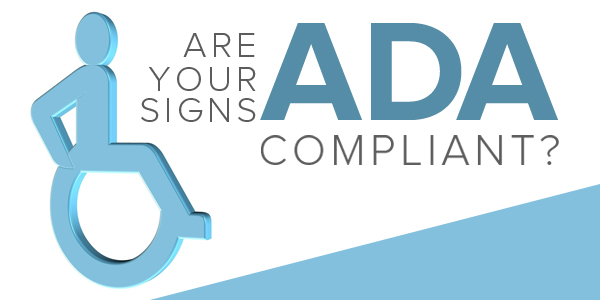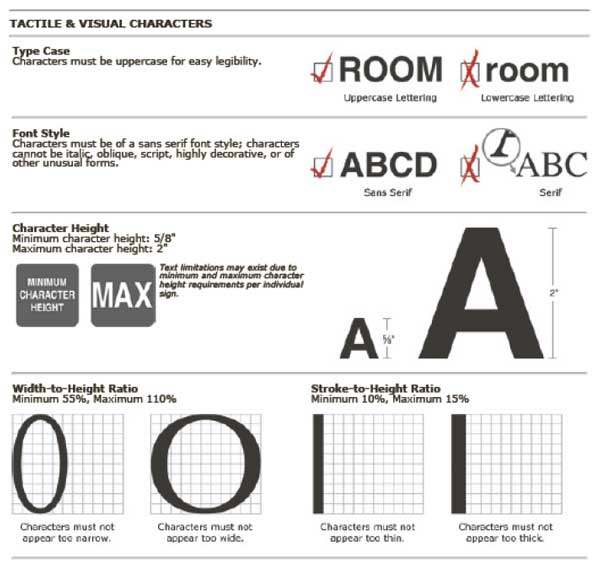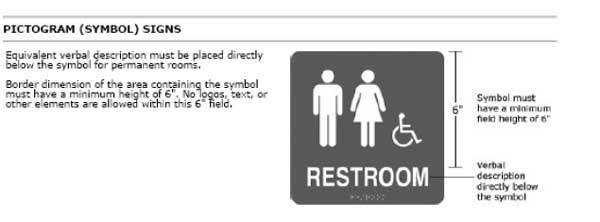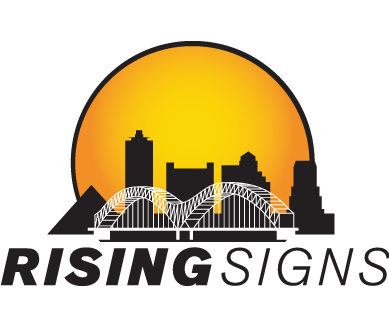Uncategorized
ADA Compliance

As a business owner why should you pay close attention to the ADA and why should you make sure your signage is compliant? To answer that simply, it is the law.
The Americans with Disabilities Act is a bill that started back in 1986 and was written into law on July 26, 1990, by President George H. W. Bush. It’s purpose is to protect people with disabilities from discrimination. It is divided into five titles. Those titles extend comprehensive civil rights protections in areas including public accommodations, state and local government services, and employment.
In Section 4.30 the law states that “In building complexes where finding locations independently on a routine basis may be a necessity (for example, college campuses), tactile maps or prerecorded instructions can be very helpful to visually impaired people. Several maps and auditory instructions have been developed and tested for specific applications. The type of map or instructions used must be based on the information to be communicated, which depends highly on the type of buildings or users.”
So when it comes to signs there are specific details that must be met for the sign to be ADA compliant. These details are:
- Sign’s Numbering and Lettering Size
- Character Height
- Braille Characters
- Sign’s Finish – It’s color and contrast
- Signage Location and Height from door and floor
We will go through what the actual law states about each.
When you consider the Numbering and Lettering Size of yours signs the actual law is that (4.30.2) “Tactile letters and numbers on signs shall have a width-to-height ratio between 3:5 and 1:1 and a stroke-width-to-height ratio between 1:5 and 1:10. The legibility of printed characters is a function of the viewing distance, character height, the ratio of the stroke width to the height of the character, the contrast of color between character and background, and print font. The size of characters must be based upon the intended viewing distance. A severely nearsighted person may have to be much closer to recognize a character of a given size than a person with normal visual acuity.”
Let’s continue with 4.30.3 and learn about Character Height, “Characters and numbers on signs shall be sized according to the viewing distance from which they are to be read. The minimum height is measured using an upper case X. Lower case characters are permitted.
Here is a visual representation to help us understand all this:


Height above minimum finished floor character height – suspended or projected 3 in (75mm).” Take for example your Restroom Signage. The male, female and accessible symbol must have a minimum field height of 6”
As a business owner you also need to consider Braille Characters and the signs finish and contrast. 4.30.4 and 4.30.5 state, “Raised and Brailled Characters and Pictoral Symbol Signs (Pictograms) – Letters and numerals shall be raised 1/32 in, upper case, sans serif or simple serif type and shall be accompanied with Grade 2 Braille. Raised characters shall be at least 5/8 in (16mm) high, but no higher than 2 in (50mm). Pictograms shall be accompanied by the equivalent verbal description placed directly below the pictogram. The border dimension of the pictogram shall be 6 in (152mm) minimum in height. Raised borders around signs containing raised characters may make them confusing to read unless the border is set far away from the characters. 4.30.5 Finish and Contrast – The characters and background of signs shall be eggshell, matt or other non-glare finish. Characters and symbols shall contrast with their background – either light characters on a dark background or dark characters on a light background.”
So you have all of that compliant? What about location of the signs and height? 4.30.6 states: Where permanent identification is provided for rooms and spaces, signs shall be installed on the wall adjacent to the latch side of the door. Where there is no wall space to the latch side of the door, including at double leaf doors, signs shall be placed on the nearest adjacent wall. Mounting height shall be 60 in (1525mm) above the finish floor to the center line of the sign. Mounting location for such signage shall be so that a person may approach within 3 in (76mm) of signage without encountering protruding objects or standing within the swing of a door.
So ok there are laws in place and they matter. In fact if your signs don’t comply it could mean you big bucks. Not only could your business lose money due to delayed openings or closings because your signs don’t pass inspection, but you could also face costly lawsuits. So no matter if you just need a bathroom sign or you need an entire signage system that complies, Rising Signs has you covered. We know the national and local laws and we make it easy and hassle free. All you need to do is just give us a call and we will take care of the details. Don’t lose time and money. Let Rising signs do it right the first time! Call our experienced team of sales reps today, 901-380-9643
